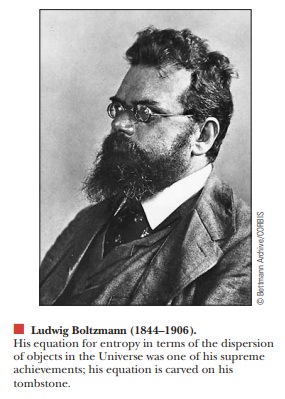Chapter: Biochemistry: Biochemistry and the Organization of Cells
Life and Thermodynamics
Life and Thermodynamics
From
time to time, one encounters the statement that the existence of living things
violates the laws of thermodynamics, specifically the second law. A look at the
laws will clarify whether life is thermodynamically possible, and further
discussion of thermodynamics will increase our understanding of this impor-tant
topic.
Is life thermodynamically possible?
The laws
of thermodynamics can be stated in several ways. According to one formulation,
the first law is, “You can’t win,” and the second is, “You can’t break even.”
Put less flippantly, the first law states that it is impossible to convert
energy from one form to another at greater than 100% efficiency. In other
words, the first law of thermodynamics is the law of conservation of energy.
The second law states that even 100% efficiency in energy transfer is
impossible.
The two
laws of thermodynamics can be related to the free energy by means of a
well-known equation:
∆G=∆H-T∆S
In this
equation, G is the free energy, as
before; H stands for the enthalpy, and S for the entropy. Discussions of the first law focus on the change
in enthalpy, ∆H, which is the heat of a
reaction at constant pressure. This quantity is relatively easy to measure.
Enthalpy changes for many important reactions have been determined and are
available in tables in textbooks of general chemistry. Discussions of the
second law focus on changes in entropy, ∆S, a
concept that is less easily described and measured than changes in enthalpy.
Entropy changes are particularly important in biochemistry.

One of
the most useful definitions of entropy arises from statistical consid-erations.
From a statistical point of view, an increase in the entropy of a system (the
substance or substances under consideration) represents an increase in the
number of possible arrangements of objects, such as individual molecules. Books
have a higher entropy when they are scattered around the reading room of a
library than when they are in their proper places on the shelves. Scattered
books are clearly in a more dispersed state than books on shelves. The natural tendency
of the Universe is in the direction of increasing dispersion of energy, and
living organisms put a lot of energy into maintaining order against this
tendency. As all parents know, they can spend hours cleaning up a
two-year-old’s room, but the child can undo it all in seconds. Similarly, cells
use a lot of energy to fight the natural tendency toward dispersion into many
different arrangements and to keep the cell structure intact.
Another statement of the
second law is this: in any spontaneous
process, the entropy of the Universe increases ( ∆Suniv> 0).
This statement is general, and itapplies to any set of conditions. It is not
confined to the special case of constanttemperature and pressure, as is the
statement that the free energy decreases in a spontaneous process. Entropy changes are particularly important
in determining theenergetics of protein folding.
Summary
Living
things are ordered assemblies of molecules. They represent a local decrease in
entropy. Because the entropy of the Universe increases in spontaneous
processes, this local decrease in entropy is offset by a larger increase in the
entropy of the surroundings. There is an increase in total entropy.
Related Topics